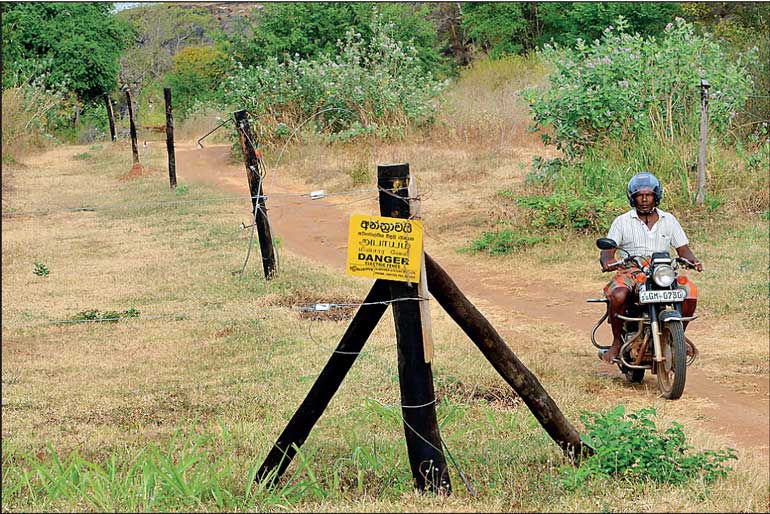Sunday Dec 14, 2025
Sunday Dec 14, 2025
Wednesday, 14 July 2021 00:00 - - {{hitsCtrl.values.hits}}

The elephant chasing crackers and electrical fences are fast becoming wasted investments in the face of these hungry, wily and wild elephants that invade human habitats – Pic by Shehan Gunasekara
 The President and the COPA have urged a quick and durable solution with policy changes to protect both humans and elephants. However, the raging Human-Elephant Conflict (HEC) continues with added vigour, destroying the lives of poor humans and wild elephants in Sri Lanka.
The President and the COPA have urged a quick and durable solution with policy changes to protect both humans and elephants. However, the raging Human-Elephant Conflict (HEC) continues with added vigour, destroying the lives of poor humans and wild elephants in Sri Lanka.
It adds insult to injury when we witness the damage being done to property, harvest and laboriously cultivated plots of those helpless, poor people whose sole livelihood is farming. Their tales of woe deserve immediate attention of the authorities.
The elephant chasing crackers and electrical fences are fast becoming wasted investments in the face of these hungry, wily and wild elephants that invade human habitats with seemingly unreserved revenge and aggression.
A couple of years ago, the Wild Life Conservation Department published a policy statement in the press on the above subject requesting public views and I promptly sent my views and long-term proposals to resolve HEC. As they appear to have fallen on deaf ears, I repeat below, the relevant proposals with updated information.
The envisaged research as per the roadmap of the department should inter-alia focus on the following home truths and long term remedial action.
1) As Sri Lanka is a small island nation, the available space for human beings, fauna and flora is very limited, making it a critical parameter.
2) With the ever-growing human and elephant population who occupy this small land mass; their food and environmental resources deplete in arithmetic progression converting the Human-Elephant Conflict (HEC) to an apparently unsolvable problem. It is reported that an elephant consumes about 150 kg of vegetation per day. With an estimated 5,600 wild elephants as at present, their food requirement works out to an astounding 840,000 kg per day! How can a small developing country like Sri Lanka cope up with such daily consumption levels?
3) We agree that Elephant Conservation (EC) is of crucial importance. However, it is quite evident from the ever increasing daily death rates of humans and elephants, that despite expensive counter measures, there is a significant imbalance in their populations. Moreover, an ongoing combined research by the Wild Life Department and the University of Peradeniya has already revealed that, carrying a wild Elephant population between 5,000 and 6,000 is relatively high for a small country of 65,610 Sq. km inhabited by a human population of more than 21 million. Therefore, a delicate equilibrium has to be struck between human and wild elephant populations to solve this elusive problem. We hope that the said research findings will throw enough and more light to convince those vociferous but sincere elephant conservationists and environmentalists to appreciate this bitter ground reality.
4) In the absence of effective birth control programmes for humans and elephants, the compelling research priority would be to ascertain the existing area-wise, the elephant population (both tame and wild) in order to determine the country’s optimum area-wise, easily manageable number of elephants for EC purposes at least at intervals of 10 years. The research will no doubt consider the main variables such as growing elephant and human populations, mortality rates, food and habitat availability and factors such as clearing of jungles for food cultivation as is increasingly happening at present including re-forestation.
5) In the event of elephant population exceeding this number, the excess numbers can be exported to interested countries without culling them. It is common knowledge that even our ancient kings had engaged in the export of elephants to Asian countries. If such elephants are exported in couples, the wild life enthusiasts in those countries will surely help to avoid Sri Lankan elephants becoming an endangered species.
Additionally, the following benefits will accrue to the people and the country:
1) Redeeming those poor farmers from their present plight of misery as a result of a short-term relocation exercise of the elephants when conducting the research.
2) Additional availability of safe habitable and cultivable land to the increasing human population in the medium and long term.
3) Saving considerable volumes of Jungle vegetation and food crops, as well as allowing expansion of food crop production and improvement of the economy of rural poor arising from a calculated preservation of the forest cover combined with reforestation programmes.
4) Reduction of wasteful foreign exchange on electrical fences, elephant chasing crackers, anaesthetics and manpower, etc., which are inimical to wildlife.
5) The savings can partly be utilised to Catch, Tame and Export (CTE) the elephant surplus.
I am confident that the above mentioned long-term export strategy can contribute towards solving many of the practical problems of HEC and EC while helping to alleviate the country’s main food and habitat requirements as well as foreign debt repayment problems in the medium and the long term.
(The writer is a and can be reached via email at [email protected])